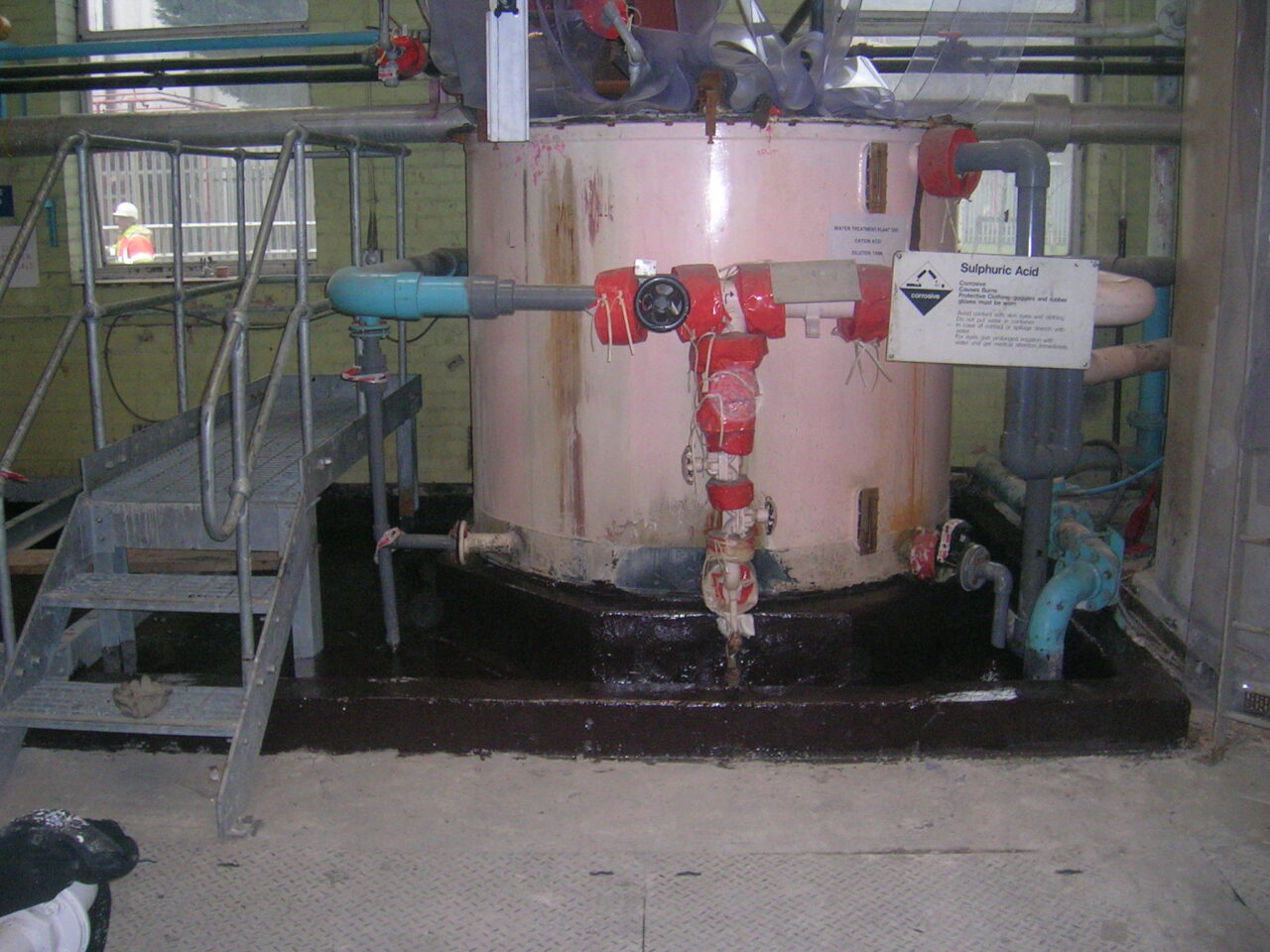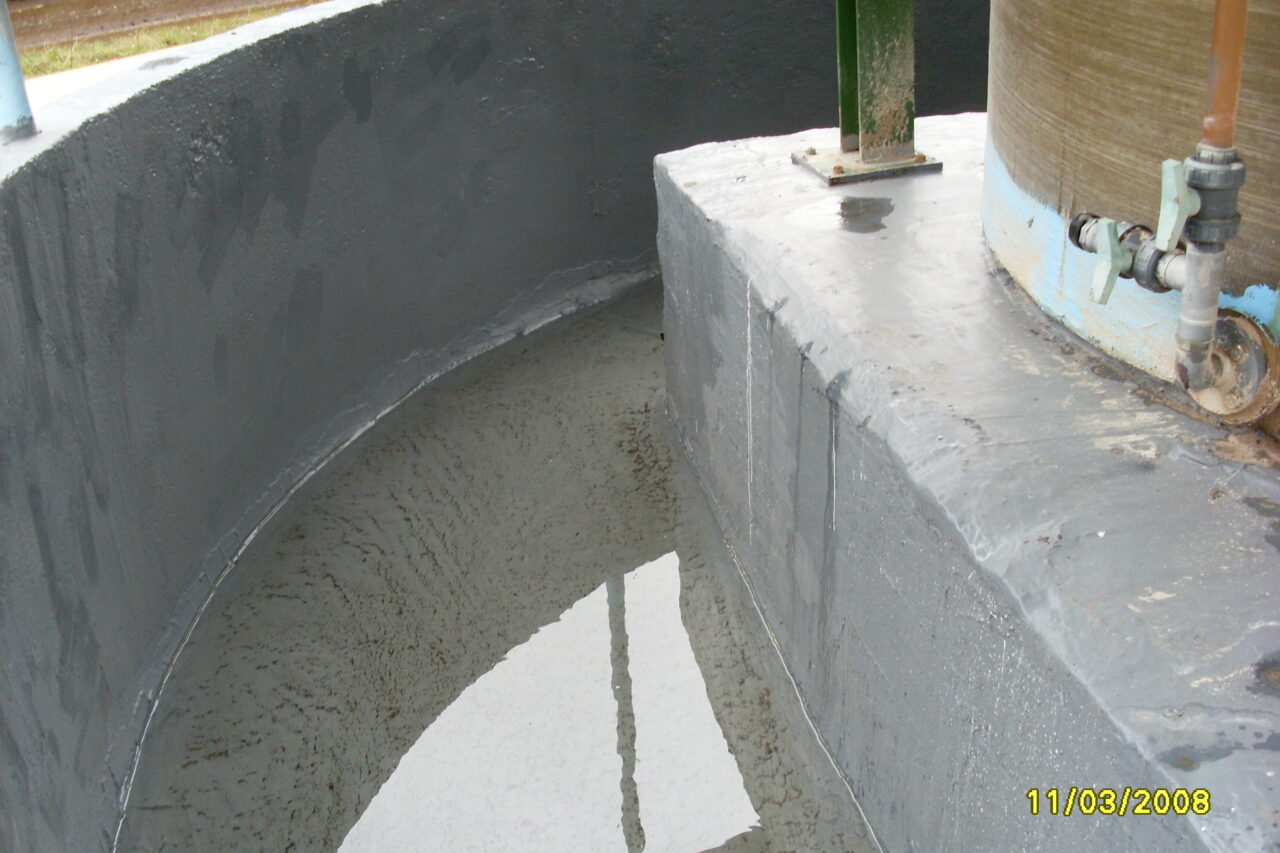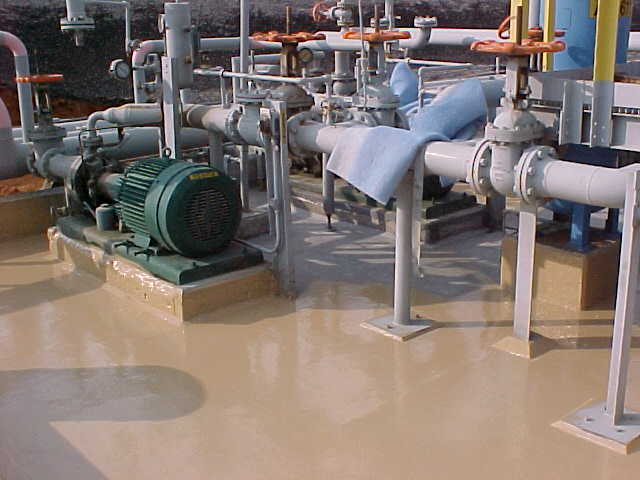Spent solvents such as methylene chloride, benzene, acetone, and their blends, additives, acids, alkalis, and lubricants among a myriad of liquid chemicals used and/or produced in different industries can present a threat to the soil, ground water, and surface water if accidentally spilled or leaked from the tanks where such materials are contained. These substances must be stored in such a way that if a spill or leak occurs, the material remains contained and does not contaminate the surrounding environment. Secondary containment areas are designed for such a purpose.
Historically, very few factory-fabricated aboveground storage tanks were built with secondary containment areas as an integral part of the tank. This approach has dramatically changed. Nowadays, newly fabricated storage tanks are typically fabricated with integral secondary containment and those already built without, are being revamped to comply with environmental protection regulations (1).
LEPA’s 40 CFR 264.193 – “Containment and detection of releases” Code provides guidance on the prevention of the release of hazardous waste or hazardous constituents to the environment by installing secondary containment for all new and existing tank systems or components prior to service. It also applies to tank systems that store or treat materials that become hazardous wastes. This code also states that secondary containment areas must be designed, installed, and operated to prevent any migration of wastes or accumulated liquid into the soil, ground water, or surface water at any time during operation of the tank. This implies that the collected materials shall be properly removed from the secondary containment area within 24 hours, or in as timely a manner as possible (2).
Secondary containment for tanks shall include at least one of the following devices:
- An external lining or coating system
- An open-top or enclosed vault
- A double-walled tank
- An equivalent device approved by the regional environmental protection agency (2)
Hence, tanks can be double-wall fabricated or single-walled with open-top steel, concrete, compacted clay, or earthen dikes or vaults. A great number of asset owners opt for integrated secondary containment areas consisting of single-wall fabricated tank in concrete dikes coated with protective coatings. This alternative seems to be preferred above the rest and will be the focus of this article.
Expected Damage During Spillage
All external coatings selected for protecting secondary containment dike concrete surfaces must be able to:
- Properly adhere to the concrete substrate,
- Contain 100% of the capacity of the largest tank within the boundary of the secondary containment areas, and
- Be chemically resistant to the stored chemical so that migration into the environment is prevented.
If external coatings are not employed and the dike concrete surfaces are exposed to the chemicals in the event of a spillage, damage could be expected, including but not limited to the following:
| Damage | Consequences |
| Increase of concrete porosity | Concrete is porous and generally not impervious to water or any other aqueous chemicals. An increase in its porosity leads to deeper penetration of such chemicals. |
| Corrosion of steel | This applies to the reinforcing bars used for strengthening concrete. Steel corrosion is a very well-known phenomenon. If steel is not protected, it is exposed to various electrolytes. Such a reaction induces deterioration of the material and as a consequence, the steel substrate can suffer from metal loss or actual failure. Furthermore, as all the corrosion products occupy a greater volume than that of the steel from which they came, additional pressure could be exerted onto the surrounding concrete. If severe enough, this pressure can overcome the cohesive strength of the concrete causing it to crack and eventually fail. |
| Cracking in concrete walls | Cracks in concrete walls are extremely frequent and sometimes happen in spite of any precautionary measures. Probably the most common reason for concrete early cracking is plastic shrinkage .Concrete shrinks before hardening, creating stress that is in turn relieved by cracking. Thermal expansion also leads to cracking. Cracking can be avoided by properly placing and spacing crack control and expansion joints. However, if a crack occurs it can grow in length and become deeper, affecting the monolithic character of the concrete wall and exacerbating ingress of chemicals. |
| Chemical attack to the bases of tanks and pumps | Chemical breakdown can cause a reduction in the compressive strength of the concrete which then can collapse under the weight of the tank and/or equipment contained within. |
| Chemical attack to joint edges and seals | Joint edges used to absorb movement due to thermally induced expansion and contraction can be damaged by exposure to chemicals in the event of a spillage. Pipe penetrations through the dike walls are typically sealed to avoid egress of chemicals. The sealant used for such a purpose shall also be chemically resistant to the stored chemicals. If not, seals might be chemically attacked allowing discharges to escape before clean-up occurs. |
| Chemical attack to dike drains | Dike drains are typically located at topographic low points of the containment floor. If the drains are chemically attacked by the spilled chemicals, they might need to be re-sloped. This, of course, implies higher maintenance costs. |
The implication of a spill though extends far beyond the monetary value of the fluids being spilled. This also implies operational shutdowns and environmental impacts with potentially disastrous consequences. For these reasons, it is paramount that asset owners and operators take a preventative approach and proactively maintain their assets, thus preventing catastrophic failures.
Polymeric Technologies – 100% Solids Epoxies for Secondary Containment Areas
As previously explained, concrete used for secondary containment could be protected with a liquid applied coating to protect it from accidental spillage. There are various coating technologies available for this purpose including polyurethanes and epoxies among others. Epoxies are polymeric materials which result from the chemical reaction of an organic epoxide group with a wide range of co-reactants to yield polymers of variable chain lengths (3). By combining different polymerization chemistries and achieving three-dimensional cross-linking, epoxies can attain outstanding properties which make them very versatile and attractive for asset owners (4). Some of them include high mechanical adhesion and strength, corrosion and erosion resistance, and chemical resilience to acids, alkalis, and solvents.
Epoxy systems can be solvent-based, water-based, or 100% solids. The former carries a big problem as it contains high volatile organic compounds (VOC) contents whereas the latter is gaining more in popularity due to its compliance with environmental and confined spaces regulations. Some other benefits of 100% solids epoxy polymeric systems include:
- Very low shrinkage during polymerization
In non solvented epoxy systems, the curing process relies on cross linking in a purely thermoset process. Thus, the film thickness of the material remains almost identical before and after curing.
2. Very low odor
Generally speaking, solvents have distinctive and penetrating odor. The lack of solvents renders 100% solids epoxies almost odorless.
3. Fewer coats to achieve desired thickness
As 100% solids epoxies do not shrink during the cure process, fewer coats are required to achieve a specific thickness when compared to solvented systems. For instance, a 50% solids epoxy coating requires two coats of 24 mils to achieve a total dry film thickness of 24 mils. As a result, more labor is required.
4. Quick return to service
Typically 100% solids epoxy systems cure through exothermic reactions. The amount of heat generated by the chemical reaction definitely influences the drying times. Quick curing provides a definite appeal for asset owners as it enables quick returns to service.
5. Better mechanical properties
100% solids epoxy systems show greater mechanical properties when compared to solvented formulations. Experimental work has shown that solvent remaining within the epoxy can hinder the cross-linking process resulting in lower exotherm, initial curing rate, reaction order, and glass transition temperature values (4).
The Solution
There are instances where the secondary containment area requires rebuilding prior to coating. This is probably the case of a storage tank that was fabricated and placed in an unprotected wall dike. The dike wall could have been exposed to chemical contamination or accidental damage, rendering it unstable and not structurally sound. It could also be due to intrinsic defects within the concrete. In either case, it is advisable to use thixotropic paste grade epoxy screeds for reconstruction purposes.
Paste grade epoxy screeds are thicker materials that are applied as a levelling layer onto floors or other cementicious surfaces and whose consistency resembles that of a molten rock. These screeds usually consist of a polymer with added mineral aggregate fillers. The amount of aggregate can be selected depending on the expected final consistency of the system. Paste grade epoxy screeds are mostly used in those cases where the substrate of the secondary containment area is already damaged and rebuilding is required prior to coating.
Once the substrate is rebuilt with paste grade epoxy screeds, the protective coating can be applied on top. A comparison between paste grade epoxy screeds and coatings for secondary containment areas protection is as follows:
| Epoxy Paste Grade Screeds | Epoxy Coatings |
| Thicker materials | Generally up to 40 mil |
| Application by brush and/or trowel | Application by brush and/or airless spray |
| Typically overcoated by fluid grade materials | Typically overcoated by fluid grade materials |
| Used for rebuilding or pit filling | Designed with additives for sag resistance, flow control, air release, etc. |
| Typically used for existing containment areas | Used for coating purposes |
| Typically used for both existing and newly fabricated containment areas |
As previously stated, for epoxy coatings to effectively protect secondary containment concrete areas they should be able to properly adhere to the substrate and be chemically resistant to the stored chemical. The adhesion to concrete and chemical resistance of epoxy materials can be assessed via dolly pull-off adhesion and chemical immersion testing, respectively.
Dolly pull off is a method of determining the adhesive strength of a coating material to a suitable prepared substrate. The test is carried out in accordance with ASTM D 4541 (5). The material to be tested is applied and allowed to cure in agreement with the instructions for use drafted by the coating’s manufacturer. Aluminum dollies are bonded onto the coating using a strong adhesive. A hydraulic adhesion tester is then employed to pull the dollies at a constant rate perpendicular to the substrate until failure is obtained.
Pull-off adhesion failure will occur along the weakest plane in the coating itself, the aluminum dolly, or the substrate. Adhesive failure modes can be observed if there is visual evidence of the coating entirely disbonding from the substrate when the dolly is pulled off. Cohesive failure modes, on the other hand, would be evident if the coating failed within itself. As concrete itself is weak in tension, it is possible for the substrate to fail cohesively when the dolly is pulled (Picture 1). This would indicate that the adhesion of the coating to the substrate is greater than the cohesive strength of the substrate itself. In general, the greater the pull-off force applied, the greater the adhesive strength of the coating material.

The chemical resistance of coatings is assessed by laboratory testing in accordance with ISO 2812-1 (6). This standard specifies general methods for determining the resistance of coating materials to the effects of other liquids rather than water.
Blasted mild steel rods of ½ inch diameter and 5 inch length are prepared for coating application. This implies that the tips of the rods are rounded to minimize risk of failure due to edge defects and the surface is blasted to SSPC SP 10 (Near White Metal) level of cleanliness with at least 3 mil profile. The rods are coated with the coating system to be tested following the Instruction for Use drafted by the coating’s manufacturer. The coating is allowed to cure and then immersed in the chemical to test at ambient or elevated temperature levels (Refer to Picture 2).

The coated rods are periodically reviewed for any sign of damage in the form of erosion, blistering, cracking or delamination. The test is typically run for 52 weeks. The observations coupled with the length of exposure of the coating to the chemical are used to assign a chemical resistance rating. As a result, at least one coating manufacturer has adopted a chemical resistance rating of Poor, Moderate, Good, and Excellent.
| Rating | Observations | Recommendation |
| EXCELLENT | No significant deterioration or damage is observed after testing length greater than 52 weeks | Suitable for long-term immersion |
| GOOD | No significant deterioration or damage is observed after testing length between 12 and 52 weeks | Suitable for short-term immersion or contact |
| MODERATE | No significant deterioration or damage is observed after testing length between 1 and 12 weeks | Suitable for short-term contact such as splashing, spillage, or secondary containment |
| POOR | Significant deterioration or damage is observed after testing length of 1 week or less | Not suitable for any application |
Rating of Moderate or Good is typically observed for coating systems to be employed in secondary containment areas.
The Application
Once the fit-for-service materials are chosen based upon adhesion to concrete and chemical resistance to potential chemicals, the next question is how to successfully deliver the solution. The answer is executing the application in strict accordance with best practices drafted by the materials’ manufacturer.
The following is an example of an application procedure for protecting a secondary containment area.
- Prior to the application
- New concrete shall be allowed to cure for a minimum of 28 days or until the moisture content is below 6% when measured with a Protimeter.
- The materials to be used shall be in their right amounts, in good condition, and transported to the application site in compliance with applicable transport requirements and accompanied with Safety Data Sheet (SDS) information.
- The environmental conditions, dew point, ambient temperature, and substrate temperature shall be monitored
- The application area shall be properly identified as per design
- The surface to be repaired shall be prepared as per NACE No. 6/SSPC-SP 13 “Surface Preparation of Concrete”.
- Application should commence as soon as the surface preparation activity has been completed. In the event that the substrate requires rebuilding, the thickness of the substrate can be rebuilt by using compatible screeding grade materials prior to application of the coating material.
- All materials shall be mixed until a homogeneous mixture is attained.
- Coating material should be applied in two contrasting coats ensuring that targeted film thicknesses per coat are obtained.
- Areas to be repaired, if any, shall be addressed prior to the final cure of the materials.
- All materials shall be allowed to cure for completion of the molecular reaction in accordance with recommended times.
Worldwide Presence
These polymeric solvent-free solutions for secondary containment protection are attractive to asset owners worldwide for various reasons. They are not only reliable and quick, but they can also be applied to both newly fabricated and existing containment areas. These solutions provide peace of mind to asset owners who can rely on a coating system that effectively protects their assets against chemicals such as sulfuric acid, hydrochloric acid, and sodium hypochlorite among others.
Example 1 – France
The integrity of this chemical containment area was compromised after regular leakage and contamination maintenance operations. The concrete substrate was rebuilt and coated with 100% epoxy materials. This containment area has been fully protected since 2003.

Example 2 – The UK
This secondary containment area was protected with a 100% solids epoxy coating against accidental contact with 98% sulfuric acid.

Example 3 – Spain
Chemical containment areas for tanks were protected from occasional spills of sodium hypochlorite.

Example 4 – USA
After several accidental spills of xylene, the chemical was leaking into the surrounding ground. EPA regulations forced the customer to seek a durable and efficient solution. The containment walls were rebuilt and protected with 100% solid epoxy materials.

References:
- McKetta, John, “Encyclopedia of Chemical Processing and Design”, Marcel Dekker, Inc. 1996
- Code of Federal Regulations 40 – Part 264
- Ebewele O. Robert, “Polymer Science and Technology”, Library of Congress Cataloging-in-Publication Data, 2000
- Pascault, Jean-Pierre et al., “Thermosetting Polymers”, Marcel Dekker, Inc., 2002
- ASTM D4541,“Standard Test Method for Pull-Off Strength of Coatings Using Portable Adhesion Testers”
- ISO 2821-1, “Paints and varnishes – Determination of resistance to liquids – Part 1: Immersion in liquids other than water.”
Interested in purchasing Belzona’s repair composites and protective coatings?
Osmay Oharriz is O&G, Petrochemicals & Chemicals Manager, Belzona.
A chemical engineer and Master in Engineering Sciences by profession, Osmay Oharriz has 8 years’ experience in the coatings industry. In his role as Oil and Gas Manager, he works with Belzona colleagues, asset owners, engineering firms, contractors, and fabricators in the oil and gas industry across all of the Americas. He has authored several technical articles and conference presentations.
A current member of NACE International, Oharriz’ background spans technical service, manufacturing, research, specification development, failure analysis, and project management. With special expertise in oil and gas, he contributes his knowledge to other industries, such as marine, waste water, and power.



